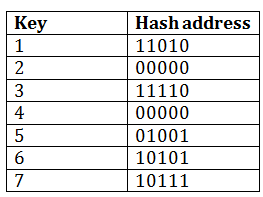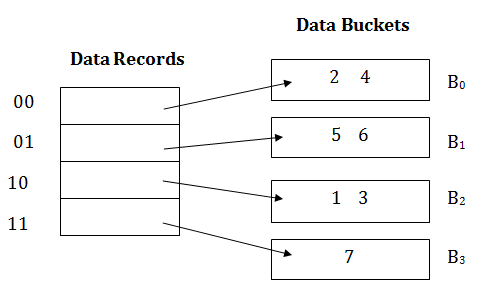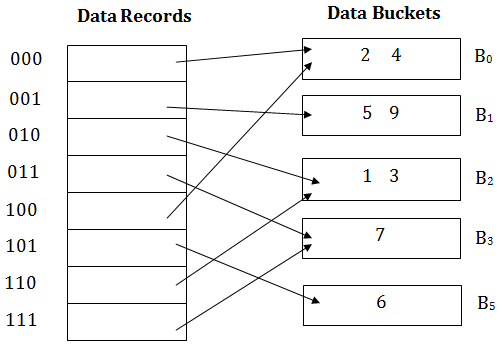Dynamic Hashing
- The dynamic hashing method is used to overcome the problems of static hashing like bucket overflow.
- In this method, data buckets grow or shrink as the records increases or decreases. This method is also known as Extendable hashing method.
- This method makes hashing dynamic, i.e., it allows insertion or deletion without resulting in poor performance.
How to search a key
- First, calculate the hash address of the key.
- Check how many bits are used in the directory, and these bits are called as i.
- Take the least significant i bits of the hash address. This gives an index of the directory.
- Now using the index, go to the directory and find bucket address where the record might be.
How to insert a new record
- Firstly, you have to follow the same procedure for retrieval, ending up in some bucket.
- If there is still space in that bucket, then place the record in it.
- If the bucket is full, then we will split the bucket and redistribute the records.
For example:
Consider the following grouping of keys into buckets, depending on the prefix of their hash address:

The last two bits of 2 and 4 are 00. So it will go into bucket B0. The last two bits of 5 and 6 are 01, so it will go into bucket B1. The last two bits of 1 and 3 are 10, so it will go into bucket B2. The last two bits of 7 are 11, so it will go into B3.

Insert key 9 with hash address 10001 into the above structure:
- Since key 9 has hash address 10001, it must go into the first bucket. But bucket B1 is full, so it will get split.
- The splitting will separate 5, 9 from 6 since last three bits of 5, 9 are 001, so it will go into bucket B1, and the last three bits of 6 are 101, so it will go into bucket B5.
- Keys 2 and 4 are still in B0. The record in B0 pointed by the 000 and 100 entry because last two bits of both the entry are 00.
- Keys 1 and 3 are still in B2. The record in B2 pointed by the 010 and 110 entry because last two bits of both the entry are 10.
- Key 7 are still in B3. The record in B3 pointed by the 111 and 011 entry because last two bits of both the entry are 11.

Advantages of dynamic hashing
- In this method, the performance does not decrease as the data grows in the system. It simply increases the size of memory to accommodate the data.
- In this method, memory is well utilized as it grows and shrinks with the data. There will not be any unused memory lying.
- This method is good for the dynamic database where data grows and shrinks frequently.
Disadvantages of dynamic hashing
- In this method, if the data size increases then the bucket size is also increased. These addresses of data will be maintained in the bucket address table. This is because the data address will keep changing as buckets grow and shrink. If there is a huge increase in data, maintaining the bucket address table becomes tedious.
- In this case, the bucket overflow situation will also occur. But it might take little time to reach this situation than static hashing.
|



 For Videos Join Our Youtube Channel: Join Now
For Videos Join Our Youtube Channel: Join Now










